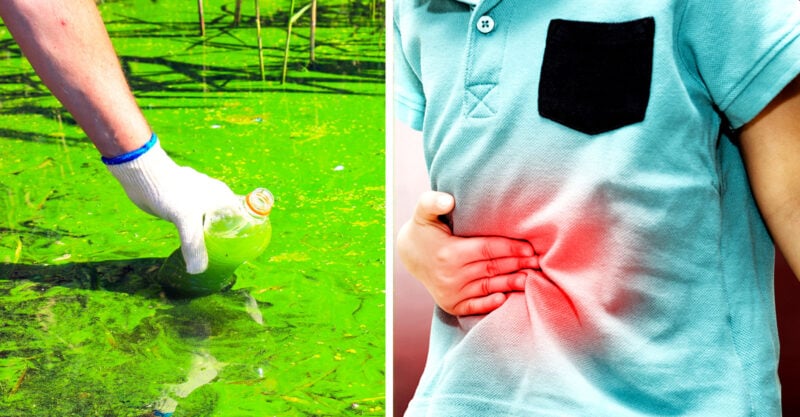Miss a day, miss a lot. Subscribe to The Defender's Top News of the Day. It's free.
More people and animals — including pets, wildlife and livestock — are getting sick from water contaminated with toxic algae compared to previous years, according to a new report by the Centers for Disease Control and Prevention (CDC).
The CDC, analyzing 2021 data, said there were 368 reports of harmful algae blooms (HABs). Fewer than 250 such blooms were reported in 2020 and 2019, the CDC said.
While not all algae blooms are dangerous, many can be harmful to human and animal health, depending on the bacteria contained in them.
For instance, the U.S. Environmental Protection Agency (EPA) considers microcystin — one of the main cyanobacteria that trigger HABs — to be a highly potent liver toxin and a potential carcinogen.
Cyanobacteria, also known as “blue-green algae,” generally release toxins into the surrounding water when their cells die or rupture, unlike other cells that continuously release toxins. However, some cyanobacteria species are capable of releasing toxins into the water without cell rupture or death.
Toxic algae blooms are fueled by polluted runoff from industrial farms that spread nitrogen and phosphorus fertilizers on their fields.
The runoff includes synthetic and animal manure fertilizers from factory farms, which house large numbers of animals and can generate as much waste as a city.
The CDC reported such blooms spike during the summer months when warmer temperatures combine with stagnant water.
For example, Florida’s Lake Okeechobee is covered by a toxic algae bloom so large it’s visible from space. The bloom was estimated to have spread across nearly 380 square miles as of June 12.
And this year, Lake Erie’s HAB, observed over the past several summers, appeared earlier than usual. Nevertheless, a recent National Oceanic and Atmospheric Association (NOAA) forecast predicted a smaller-than-average bloom for the lake.
According to NOAA:
“The size of a bloom isn’t necessarily an indication of how toxic it is. For example, the toxins in a large bloom may not be as concentrated as in a smaller bloom. Each algal bloom is unique in terms of size, toxicity and ultimately its impact on local communities.”
Symptoms, including neurotoxic issues, may be most severe for small children
The CDC said 16 states in 2021 reported a total of 117 human illnesses and at least 2,715 animal illnesses as a result of toxic blooms. The actual numbers are likely higher, they said, because not all states participated in reporting illnesses and the voluntary nature of the data collection system.
Of the 117 human illness cases, close to half were among people under age 18, suggesting children and teens may be at higher risk of exposure and illness than adults.
Toxic exposure can occur through ingestion, inhalation or skin contact with waters containing a HAB.
The majority of human cases reported were predominately from exposure to HABs at public outdoor areas and beaches, the CDC said.
Since kids are more likely to ingest large quantities of water while swimming or spend more time playing in water than adults, they have a greater risk of exposure, according to the nonprofit Environmental Working Group (EWG).
The people sickened by toxic algae exposure reported numerous symptoms, with gastrointestinal (i.e., stomach pain, vomiting and diarrhea), dermatologic (i.e., skin irritation), and generalized (i.e., fever and headaches) being the most common.
Prior studies showed some severe cases of exposure to HABs resulted in lasting organ damage, such as acute kidney disease and liver failure. Other research suggests symptoms may be especially severe for children due to their smaller bodies, and may include neurotoxic effects.
Cyanotoxin exposure has also been linked to an increased risk of developing Lou Gehrig’s disease, the progressive degenerative disease also known as ALS, and a higher risk of Alzheimer’s and Parkinson’s Disease and dementia.
In addition to preventive measures, EWG recommended immediate treatment. “If you think your child has come into contact with toxic algae, or shows unusual or flu-like symptoms after playing in or near an outbreak, rinse them off with water and make sure they drink plenty of water.”
“You may want to also seek medical attention as soon as possible, especially if symptoms are serious or persist,” EWG added.
Animals fared worse than humans
Of the 2,715 animal illnesses reported, 92% resulted in death. More than 2,000 of the HAB-related animal deaths were among wild bats in Washington state.
There were 48 domestic pet illnesses reported — all dogs — and 25 livestock illnesses.
Fish, mollusks and marine animals also got sick from exposure to the toxic algae.
CDC promotes ‘One Health’ surveillance but leaves root cause unaddressed
The CDC concluded its report by promoting the merit of its “One Health” surveillance system, stating:
“A One Health approach to surveillance increases the scientific understanding and data available to characterize HAB events and inform illness prevention efforts.”
The CDC said its One Health Office “works within the United States and with other countries and regions to build strong partnerships and takes a strategic, targeted approach to control and prevent zoonotic and emerging infectious diseases and other One Health issues.”
One of the office’s primary jobs is to “prepare for and respond to outbreaks and public health emergencies, such as Ebola, Zika, and COVID-19.”
The office is also actively working to “spur progress” toward the full implementation of the World Health Organization’s international health regulations.
While the CDC called for increased surveillance of HABs, the agency did not directly address how HABs might be prevented from occurring.
For instance, the agency did not explicitly call out industrial farming practices as a primary contributor to HABs, but rather noted that HABs can be “intensified” by “nutrient pollution.”
The report stated:
“HAB events of public health concern are primarily caused by microalgae (e.g., diatoms and dinoflagellates), cyanobacteria, and the toxins they can produce.
“HAB events, which can be intensified by factors such as nutrient pollution and warmer water temperature, can have public health, environmental, and economic impacts.”
Despite the agency’s stated mission of protecting Americans from “health, safety and security threats,” the report failed to discuss actions that might reduce the growing proliferation of HABs, such as shifting to regenerative farming methods that would decrease fertilizer runoff from industrial farms.
Commenting on the problem of toxic algae blooms, EWG said, “We need policy changes to drastically reduce runoff from farm fields and control algae outbreaks, ensuring the safety of our drinking water and recreational waterways.”
Kathleen Merrigan, Ph.D., an expert in food and agriculture and former U.S. deputy secretary of agriculture, pointed out that excess fertilizer runoff from farms is largely responsible for HABs. She said:
“Excess fertilizer washes off of fields during storms and runs into rivers and lakes where it fertilizes huge blooms of algae that die and decompose, depleting oxygen in the water and creating ‘dead zones’ that can’t support fish or other aquatic life.
“This process — called ‘eutrophication’ — is a major problem in the Great Lakes, the Chesapeake Bay, the Gulf of Mexico and many other U.S. water bodies.”
Merrigan, who directs the Swette Center for Sustainable Food Systems at Arizona State University, said the ongoing synthetic fertilizer crisis is yet another reason why industrial farms should shift to regenerative farming methods.
“I believe now is an opportune time for USDA [U.S. Department of Agriculture] to offer incentives for adopting biologicals, as well as practices that organic farmers use to replace synthetic fertilizers, such as crop rotation, composting and raising crops and livestock together,” she said.
Environmental activist and food sovereignty advocate Vandana Shiva, Ph.D., pointed out that the manufacture of synthetic fertilizers is highly energy-intensive.
“One kg of nitrogen fertilizer requires the energy equivalent of 2 liters of diesel,” Shiva said. “Energy used during fertilizer manufacture is equivalent to 191 billion liters of diesel in 2000 and is projected to rise to 277 billion in 2030.”
She added:
“The scientific and just response to the nitrogen problem is to shift from fossil fuel chemical agriculture to biodiverse ecological agriculture and regenerative farming and to create transition strategies for farmers to shift to ecological agriculture, which regenerates soil nitrogen while making farmers free of harmful and costly chemicals.”






